Abstract
The functionalization of nitrogen-doped graphene with β-Cyclodextrin (designated β/N-rGO) was employed to enhance the dispersibility of graphene materials and to establish an adsorption-catalytic oxidation system using peroxymonosulfate (PMS) for the removal of trace antibiotics from water. The experimental results indicated that β-Cyclodextrin was effectively dispersed on the support structure of nitrogen-doped graphene, which enhanced the specific surface area and dispersibility of the material. The adsorption-catalytic oxidation system comprising β/N-rGO and PMS degraded 92.35% of sulfamethoxazole within 12 min and exhibited significant removal efficiency for sulfonamides, quinolones, macrolides, tetracyclines, β-lactams, and chloramphenicol antibiotics across a pH range of 3–12. The reaction time was reduced by over 10% compared to the unmodified material, with a more pronounced improvement in treatment efficiency, particularly under low-pH conditions. The activation energy of β/N-rGO was estimated to be approximately 4.5 kJ/mol, and elevated temperatures accelerated the reaction, with the removal rate remaining above 85% after five regeneration cycles. Quenching experiments and EPR spectra confirmed that the primary pathway for PMS activation by β/N-rGO was a non-radical process dominated by singlet oxygen. These findings broaden the research and application scope of cyclodextrin–graphene interactions and provide a feasible approach for the removal of trace antibiotics from water.
1. Introduction
The advantages and characteristics of graphene, including its large specific surface area, high electrical conductivity, excellent catalytic properties, high carrier density, good optical transmittance, and chemical stability, are well recognized. These properties enable its widespread application in fields such as sensors, electronics, composites, optoelectronics, bioengineering, and energy production and storage, demonstrating significant promise [1,2,3,4]. Graphene, with its unique electronic structure and tunability, holds significant potential for catalytic applications and is utilized to activate oxidants such as H2O2, KIO4, O3, and persulfate (PS) for the degradation of organic pollutants in water. In the presence of graphene-based materials, the degradation efficiency of oxidants is significantly enhanced, with peroxymonosulfate (PMS) being the most commonly used oxidant that forms a catalytic oxidation system with graphene [5,6,7,8,9]. The catalytic mechanisms of the graphene-based carbon catalyst/PMS system involve both radical and non-radical pathways, with key differences reflected in oxidative selectivity, oxidative potential, the nature of active oxidizing species, and the pH effect. However, the hydrophobicity of graphene and the strong Van der Waals forces between its layers promote agglomeration, which significantly impairs the catalytic performance of the material and limits its application in composites [10,11,12,13].
The methods to overcome the agglomeration of graphene-based materials and improve their dispersion performance primarily involve two categories: physical and chemical methods. Physical methods include mechanical stirring, ball milling, ultrasonic assistance, and other techniques that improve the dispersion of graphene in aqueous solutions but do not alter the internal molecular structure of graphene nor do they fundamentally address the issue of graphene agglomeration [14,15,16,17]. Chemical methods can fundamentally address graphene agglomeration and enable the functional modification of graphene materials, primarily through covalent bonding to graft free radicals or chemical reagents, oxygen-containing groups, and organic functional groups onto the edges or bases of C-C bonds. Additionally, Van der Waals forces, π–π interactions, hydrogen bonding, and other effects between surfactants and graphene can increase the repulsive forces between graphene layers, mitigating agglomeration [18,19,20,21,22]. β-Cyclodextrin (β-CD) and graphene are among the commonly used functionalized materials that can form supramolecular hybrids, either covalently or non-covalently, and are widely applied in water pollution treatment and catalysis. β-CD is a cyclic oligosaccharide composed of seven glucose units linked by α-1,4-glycosidic bonds, characterized by a specific cavity structure, external hydrophilic, and internal hydrophobic properties. These properties enable β-CD to selectively bind various organic, inorganic, and biological guest molecules into its cavities, forming stable host–guest inclusion complexes or nanostructured supramolecular assemblies in hydrophobic environments, exhibiting high molecular selectivity and enantioselectivity [23,24,25]. β-CD is water soluble, and its combination with other materials can enhance the solubility and stability of target functional materials in aqueous solutions. Therefore, modifying various graphene materials with β-CD can combine the common characteristics of both, resulting in new materials with unique properties, including a large specific surface area, high catalytic and enrichment abilities, and enhanced solubility and stability. It was reported that β-CD can effectively reduce the agglomeration of graphene and enhance its adsorption performance [26,27,28,29,30,31]. Cyclodextrin-modified graphene oxide with a three-dimensional porous structure (CD-GAM), as prepared by Nie et al., exhibits an excellent broad-spectrum adsorption of organic micropollutants. Its adsorption capacities for 2,4-dichlorophenol, propranolol hydrochloride, ethyl estradiol, and bisphenol a reached equilibrium within 10 min, and the regeneration adsorption capacity of CD-GAM remained above 80% over five cycles [32]. At present, the influence of the interaction between cyclodextrin and graphene was primarily investigated in terms of collaborative adsorption and electrochemical sensing applications. Although studies showed that cyclodextrin mitigates graphene layer agglomeration, the underlying mechanism remains unclear [33,34,35].
Environmental problems such as drug resistance, persistent pollution, and the challenging degradation of these compounds due to antibiotic overuse have garnered significant attention. Currently, over 250 types of antibiotic drugs are registered, among which sulfonamides (e.g., sulfamethoxazole, SMZ), quinolones (e.g., levofloxacin, LVX), macrolides (e.g., clindamycin, CLI), tetracyclines (e.g., tetracycline, TC), β-lactams (e.g., penicillin, PEN), and chloramphenicol (e.g., chloramphenicol, CHL) are frequently detected in aquatic environments across a broad spectrum of species [36,37]. Existing studies showed that conventional water treatment processes are not capable of completely degrading antibiotics, particularly given the diverse range of antibiotic compounds found in natural water systems. This is primarily because antibiotics in aqueous environments often exist at trace concentrations, which limits the efficiency of conventional treatment methods. Therefore, addressing antibiotic contamination at micro or trace levels necessitates either enhancing current treatment methods or developing novel, practical technologies to mitigate the adverse effects of antibiotic resistance on human health and ecosystems [38,39,40]. In a previous study, an adsorption-catalyzed oxidation (ACO) system was developed, employing nitrogen-doped reduced graphene (N-rGO) with various nitrogen-doping forms and PMS, which demonstrated high efficiency in degrading several of the aforementioned trace-level antibiotics in aqueous environments [41,42]. In this study, building on the use of β-CD to mitigate the agglomeration of N-rGO, we first investigated whether β-CD doping influences the catalytic performance of N-rGO and the efficiency of the ACO system. Secondly, we examined whether β-CD’s ability to enhance the dispersion of graphene materials is affected in a strong oxidation environment. Given the widespread occurrence and high concentrations of sulfonamide drugs in the environment, they often coexist with various impurities at trace levels in both solid and liquid matrices, and their metabolites exhibit potential toxicity. Therefore, this study employed SMZ as the primary model compound to investigate the effects of enhanced oxidation systems on antibiotic degradation and the role of matrix components in aqueous environments [43]. This study expands the research and application scope of the interaction between cyclodextrins and graphene, addressing the detrimental effects of agglomeration and dispersion on the performance of graphene-based materials.
2. Results and Discussion
2.1. Properties of Catalytic Materials
From the elemental composition in Table 1, it can be observed that the primary elemental compositions and their respective contents in β/N-rGO and N-rGO are similar, with the nitrogen percentage being particularly close, thereby providing comparable conditions for an analysis of the two materials. As shown in the SEM image of Figure 1a, β/N-rGO retained similar structural characteristics to those of N-rGO (Figure 1b), exhibiting folds on both surfaces, a smooth appearance, and a semi-transparent state. However, the stacking phenomenon in β/N-rGO became more pronounced following the addition of β-CD, with the folds between the lamellae becoming more prominent. Additionally, the defects at the edges were more apparent, accompanied by a layer of rough coverage and significant stacking, indicating that β-CD bonded with the graphene [32]. The elemental composition and SEM images of N-rGO presented in Table 1 and Figure 1 were derived from the previous work conducted by our research group [41].

Table 1.
Elemental composition of various nitrogen-doped graphene materials.
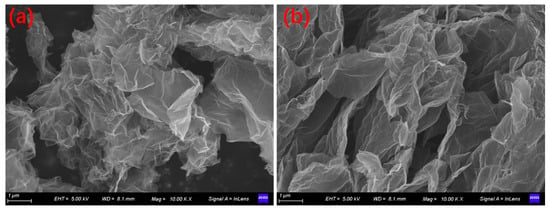
Figure 1.
SEM of β/N-rGO (a) and N-rGO (b).
As shown in Figure 2a, the absorption peaks at 3390 cm−1, 1627 cm−1, 1397 cm−1, and 1032 cm−1 observed in N-rGO were also present in β/N-rGO. The peak at 3390 cm−1 is attributed to the stretching vibrations of -OH and -COOH groups, while the peaks at 1627 cm−1 and 1032 cm−1 became sharper, corresponding to the anti-symmetric glycosidic (C-O-C) stretching vibration and another characteristic feature of the β-CD monomer, respectively [44]. Additionally, β/N-rGO exhibited a new absorption peak at 2924 cm−1, attributed to the aliphatic -C-H stretching vibration, a characteristic feature of β-CD. In conclusion, the appearance of the above characteristic peaks in the FTIR spectra confirmed the successful grafting of β-CD onto N-rGO [45]. Figure 2b shows characteristic shifts in the D and G bands for both graphene-based materials, indicating that the modification of N-rGO by β-CD did not alter the integrity of the graphene structure. However, the ID/IG ratio decreased, suggesting that β/N-rGO contained a higher proportion of sp2-hybridized carbon atoms. This may be attributed to the introduction of sp2-hybridized carbon atoms from β-CD during grafting. A higher proportion of sp2-hybridized carbon atoms correlates with fewer defects, which was shown in the literature to enhance the π–π interactions between the material and contaminants [46]. The infrared and Raman images of N-rGO presented in Figure 2 were derived from the previous work conducted by our research group [41].
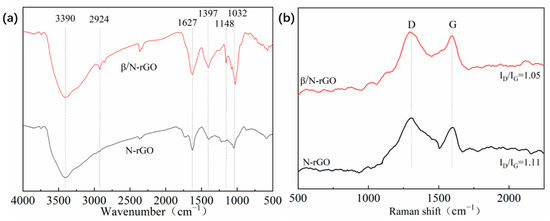
Figure 2.
The FTIR spectra (a), Raman spectra (b) of different materials.
Figure 3a presents the full-scan XPS spectra of β/N-rGO and N-rGO. The C1s, N1s, and O1s peaks at 298 eV, 400 eV, and 533 eV, respectively, confirmed the successful doping of nitrogen atoms in both materials, consistent with previous literature reports. However, the O1s peak at 533 eV in β/N-rGO was significantly higher than in N-rGO, which may be attributed to the higher O:C ratio of β-CD, leading to an increased oxygen content in β/N-rGO [47]. Figure 3b,c reveal that β-CDβ-CD significantly altered the carbon and nitrogen structures of β-CD-functionalized N-rGO compared to N-rGO, despite similar nitrogen content. The percentage of graphite-type N increased by 5.26% and pyrrole-type N rose by 27.28% while pyridine-type nitrogen decreased by more than 30%.

Figure 3.
The XPS survey (a), N1s scan of β/N-rGO (b), and N-rGO (c).
2.2. Degradation Kinetics Analysis
Numerous studies demonstrated that β-CD can increase the specific surface area and active sites of graphene, thereby enhancing its adsorption capacity for pollutants [30,31]. Additionally, research showed that metal catalysts modified by β-CD can improve the catalytic effectiveness of PMS [28,48]. To investigate the effect of β-CD on PMS activation by N-rGO in the “adsorption-catalytic oxidation” system, β/N-rGO was introduced into the system to analyze its kinetic process. According to the elemental analysis in the previous section, the nitrogen content of β/N-rGO was 2.93%, closely matching that of N-rGO (2.99%). The effect of β-CD on the degradation of SMZ in the “adsorption-catalytic oxidation” system was then compared under both materials with similar nitrogen content (Figure 4a). β/N-rGO accelerated the catalytic reaction of PMS, enhancing the production of ROS and improving the degradation rate of antibiotics in the “adsorption-catalytic oxidation” system. SMZ degradation was completed within 12 min, which was more than 10% faster than the N-rGO + PMS system. Additionally, as shown in the inset of Figure 4a, the specific surface area of the β-CD-modified N-rGO was 267 m2/g, 15.09% higher than that of N-rGO, and its adsorption capacity increased by approximately 5%, thereby enhancing the material’s adsorption performance.
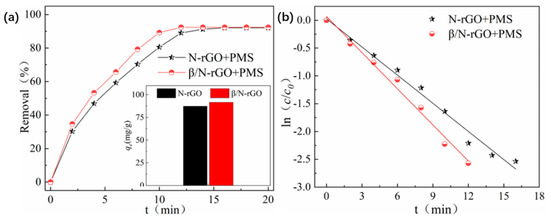
Figure 4.
Degradation efficiency (a) and its first-order kinetic fit (b) of the two material systems for sulfamethoxazole (C0 = 10 μg/L, Cβ/N-rGO = 0.1 mg/L, CN-rGO = 0.1 mg/L, CPMS = 1 mg/L, T = 288.15 K), and the inset shows the adsorption capacity of the two materials for sulfamethoxazole.
To further investigate the characteristics of the “adsorption-catalytic oxidation” system, the degradation rates of the different systems were fitted to the first-order kinetic equation. The fitting equation is provided below, with the results shown in Figure 4b and the kinetic model parameters listed in Table 2. The infrared and Raman images of N-rGO presented in Figure 2 were derived from the previous work conducted by our research group [41].
where c and c0 are the antibiotic concentration at moment t and the initial moment of the reaction, respectively, mg/L; k1 is the first-order kinetic rate constant, min−1.

Table 2.
First-order kinetic model parameters of different degradation modes.
The fitting results indicated that the R2 values of the equations were all greater than 0.98, confirming that the degradation process closely followed the first-order kinetic model. Comparison of the reaction kinetic parameters revealed that the half-life for PMS activation by β/N-rGO was 22.14% shorter than that of N-rGO, indicating a faster PMS degradation rate for SMZ catalyzed by β/N-rGO at all concentrations.
2.3. Analysis of Influencing Factors
2.3.1. Influence of pH Value
As shown in Figure 5a, β/N-rGO exhibited superior PMS catalytic ability after β-CD modification compared to N-rGO across the pH range of 3–12, overcoming the pH dependence inherent in traditional advanced oxidation processes to some extent. Additionally, since the structures of various antibiotics are closely related to pH conditions, the degradation efficiency of the β/N-rGO + PMS “adsorption-catalytic oxidation” system was further examined for a range of antibiotics, including quinolones (LVX), macrolides (CLI), tetracyclines (TC), β-lactams (PEN), and chloramphenicol (CHL), across different pH values, with the results presented in Figure 5b–c. The removal rates of SMZ, LVX, TC, and PEN were significantly reduced under low-pH conditions, dropping to approximately 85%. This reduction is likely due to the competitive effect of the excess H+ ions at low pH, which interacted with the catalyst’s active sites and the negatively charged chain-catalyzed reaction intermediates (e.g., HSO5−), prematurely terminating the chain reaction. This led to a decrease in ROS and a subsequent reduction in degradation efficiency [12]. As shown in Figure 5c, compared to the N-rGO + PMS system, the degradation efficiency of the modified “adsorption-catalytic oxidation” system for the above antibiotics was improved to varying degrees, with a significant enhancement in the degradation of SMZ, LVX, TC, PEN, and CHL under low-pH conditions. Therefore, the functionalization of N-rGO with β-CD enhanced the catalyst’s adaptability to varying pH conditions. Notably, antibiotic degradation efficiency increased with rising pH levels, as alkaline activation is a primary mechanism for PMS activation. Alkaline conditions promote the decomposition of PMS into reactive species such as superoxide radicals and singlet oxygen. Singlet oxygen is a highly selective oxidant that readily reacts with electron-rich compounds, including antibiotics. In practical water treatment scenarios, wastewater typically exhibits a neutral pH. Enhanced removal efficiency under neutral or alkaline conditions facilitates practical application, particularly in treating alkaline wastewaters such as those from textile and medical industries. Furthermore, the inherent characteristics of such wastewater can further enhance antibiotic degradation within the treatment system. [49,50].

Figure 5.
(a) Degradation of SMZ by two material systems at different pH values (C0 = 10 μg/L, Cβ/N-rGO = 0.1 mg/L, CPMS = 1 mg/L, T = 288.15 K), (b) degradation of different antibiotics by β/N-rGO-catalyzed PMS at different pH values (C0 = 10 μg/L, Cβ/N-rGO = 0.1 mg/L, CPMS = 1 mg/L, T = 288.15 K), (c) the ratio of the removal rate between cyclodextrin-functionalized and unfunctionalized “adsorption-catalytic oxidation” systems.
2.3.2. Effect of Temperature
As shown in Figure 6, the time to reach reaction equilibrium was significantly reduced with increasing temperature, indicating that higher temperatures positively promote the β/N-rGO-catalyzed PMS process. At 308.15 K, the degradation of antibiotics can be completed within 8 min, which is more than 30% faster than the degradation reaction time at ambient temperature (298.15 K). The change in reaction rate is further illustrated by fitting the apparent kinetic constants at different temperatures (see Table 3). The reaction rate constant at 308.15 K was over 50% higher than that at 288.15 K. These results indicated that increasing temperature rapidly enhanced the reaction rate, likely due to the temperature dependence of the carrier mobility in β/N-rGO. This aligns with the temperature effect observed in nitrogen-doped carbon-based catalysts (e.g., carbon nanotubes), as reported in previous studies [51]. Additionally, the activation energy of β/N-rGO, calculated using the Arrhenius equation, was approximately 4.15 kJ/mol, much lower than that of cobalt- or manganese-loaded nanocarbon catalysts reported in the literature [41]. This suggests that more molecules can cross the activation energy barrier at a given temperature for β/N-rGO catalysts, enhancing catalytic efficiency.
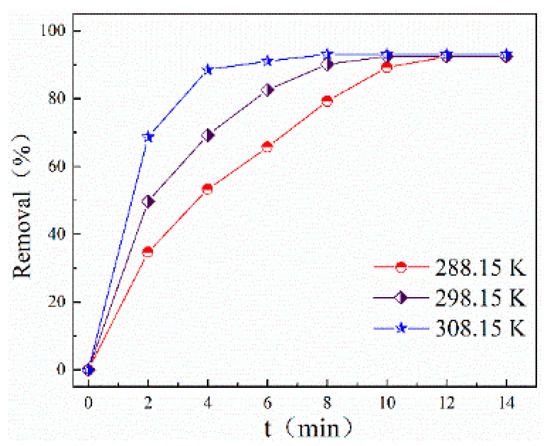
Figure 6.
Effect of temperature on antibiotic degradation efficiency (C0 = 10 μg/L, Cβ/N-rGO = 0.1 mg/L, CPMS = 1 mg/L)

Table 3.
Calculation results of activation energy and related parameters.
2.3.3. Effect of Initial Antibiotic Concentration on Degradation Effect
In natural waters and municipal wastewater, the concentrations of various antibiotics typically range from 1 to 100 μg/L. To evaluate the system’s efficacy in treating low-antibiotic concentrations, a maximum concentration of 20 μg/L was selected [52]. As shown in Figure 7, the “adsorption-catalytic oxidation” system comprising β/N-rGO and PMS effectively degraded trace antibiotics at concentrations ranging from 1 to 20 µg/L within 12 min. This indicated that the catalyst’s degradation efficiency was unaffected by the initial antibiotic concentration. In simple adsorption, high initial pollutant concentrations reduce the number of available adsorption sites on the adsorbent, limiting its capacity to adsorb pollutants at higher concentrations. In the “adsorption-catalytic oxidation” system, the active sites on the surface of β/N-rGO serve dual roles of adsorption and catalysis. Excess antibiotics are adsorbed onto the material’s surface, and the PMS present rapidly removes the excess pollutants through ROS produced by PMS catalysis on β/N-rGO. This process mitigates the issues caused by excessive adsorption. Therefore, in the “adsorption-catalytic oxidation” system, the coexistence of adsorption and catalysis allows β/N-rGO to sustain a continuous process of adsorption, catalysis, and oxidative degradation of trace antibiotics in water. As shown in Table 4, the “adsorption-catalytic oxidation” system demonstrated the advantages of a rapid removal rate and high removal efficiency for trace-level antibiotics in water compared to other treatment methods.
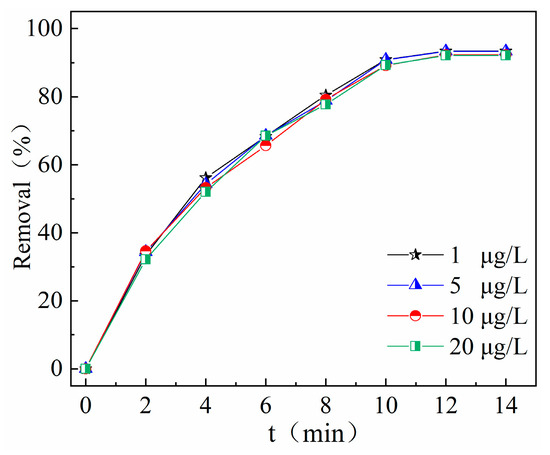
Figure 7.
Effect of initial antibiotic concentration on degradation effect (CPMS = 1 mg/L, Cβ/N-rGO = 0.1 mg/L, T = 288.15 K).

Table 4.
Comparison with other treatments.
2.3.4. Effect of PMS Concentration
As shown in Figure 8, the concentration of PMS played a crucial role in influencing the degradation efficiency. At lower PMS concentrations, the limited amount of oxidant significantly reduced the generation of reactive oxygen species through catalytic activation, leading to insufficient oxidation capacity and diminished degradation performance. The removal rate of SMZ by the system decreased by 4.55%, and the reaction equilibrium time was prolonged by 33.33%. Figure 8 also clearly illustrates that, during the initial phase of the reaction, the degradation curve rose sharply, whereas it leveled off in the later stages. This observation supports the conclusion that, although the overall oxidant dosage was low, the relatively higher PMS concentration in the early phase promoted the generation of reactive species, leading to an enhanced degradation efficiency at the beginning of the reaction. When the concentration of PMS increased to 5 mg/L, the reaction rate and removal rate did not decrease with the increase in the oxidant content; instead, they decreased. This may be attributed to two primary factors: First, the catalyst dosage was fixed, and the limited number of active sites created a bottleneck in the catalytic oxidation process. Secondly, an excess of PMS can initiate a chain reaction of free radicals, resulting in self-quenching. In this scenario, the free radicals were consumed through side reactions, triggering a scavenging effect that reduced the concentration of reactive radicals or generated fewer reactive species, thereby diminishing the overall degradation efficiency [56].
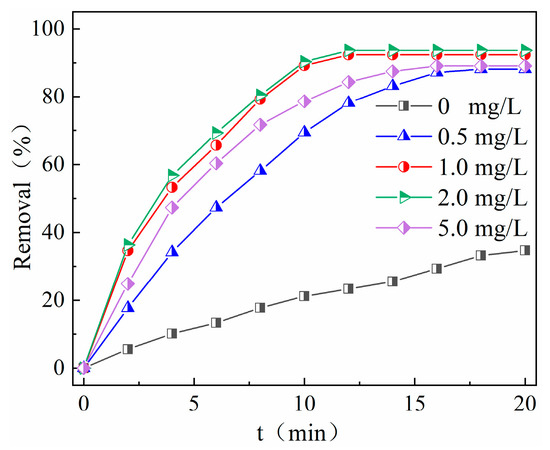
Figure 8.
Effect of PMS concentration degradation (C0 = 10 μg/L, Cβ/N-rGO = 0.1 mg/L, T = 288.15 K).
2.3.5. Effect of Anions on Degradation Effect
As shown in Figure 9, the removal of SMZ by the “adsorption-catalytic oxidation” system consisting of β/N-rGO and PMS was unaffected by the addition of excessive anions, suggesting that PMS activation by β/N-rGO may proceed via a non-radical pathway. In comparison to the free radicals generated by conventional PMS activation (e.g., ·SO4−,·OH), the inhibition or enhancement of these free radicals did not affect the degradation rate of antibiotics when sufficient amounts of carbonate (HCO3−, CO32−), nitrate (NO3−), or phosphate (HPO42−, H2PO4−) were added. Furthermore, it was reported that the addition of chloride ions (Cl−) can activate PMS to produce free radicals, such as ·Cl2, ·Cl, and ·ClOH, which possess an oxidizing capacity similar to that of ·SO4− and ·OH, thereby promoting pollutant degradation. Additionally, when ·Cl is not involved in organic matter degradation, it may act as a scavenger for ·SO4−, reducing the degradation rate of organic matter. However, in this experiment, the addition of Cl− did not affect the degradation rate of organic matter. In conclusion, the degradation of antibiotics in the “adsorption-catalytic oxidation” system comprising β/N-rGO and PMS primarily followed a non-radical pathway [57,58,59,60].

Figure 9.
Effect of different anions on degradation effect (C0 = 10 μg/L, Cβ/N-rGO = 0.1 mg/L, CPMS = 1 mg/L, Canion = 100 mmol/L, T = 288.15 K).
2.3.6. Effect of Humic Acid on Degradation Effects
Humic acid contains a significant number of phenolic hydroxyl and carboxyl groups, which may adsorb to the surface of β/N-rGO, thereby obstructing the catalytically active sites and diminishing degradation efficiency. Thus, we further investigated the impact of humic acid on degradation efficiency. As shown in Figure 10, the presence of humic acid at concentrations ranging from 1 to 10 mg/L had less than a 1% impact on the degradation of SMZ in the “adsorption-catalytic oxidation” system, suggesting that its influence on antibiotic degradation by this catalyst was negligible. One possible explanation is that a large number of ROS were generated during SMZ degradation in the “adsorption-catalytic oxidation” system, leading to the rapid removal of phenolic hydroxyl and carboxyl groups in humic acid, thereby maintaining the continuity of the “adsorption-catalytic oxidation” process. This active oxygen encompasses not only free radicals such as ·SO4− and ·OH but also a significant number of non-free radical species. Therefore, compared with pure free radical reactions, the β/N-rGO-catalyzed PMS system exhibited stronger resistance to interference from humic acid, thereby overcoming the limitations of individual adsorption or free radical reactions, which are significantly influenced by natural organic matter.
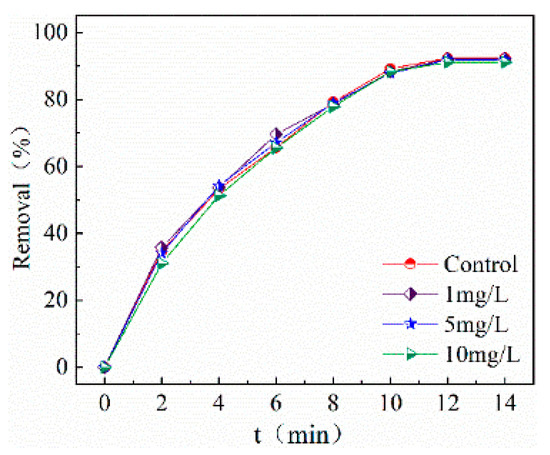
Figure 10.
Effect of humic acid on degradation effect (C0 = 10 μg/L, Cβ/N-rGO = 0.1 mg/L, CPMS = 1 mg/L, T = 288.15 K).
2.3.7. Impacts of Recycling and Regeneration
Figure 11 illustrates the effects of the two recycling methods on the catalytic performance of the β/N-rGO. It was evident that the performance of the regenerated catalysts surpassed that of direct recycling, with this difference becoming more pronounced as the operation cycle was extended. When β/N-rGO was directly recycled without regeneration, although antibiotics and their degradation intermediates adsorbed on the catalyst surface can be rapidly removed by catalytically generated ROS, the delayed removal of pollutants over extended operation cycles led to a reduction in the active sites on the β/N-rGO surface due to coverage, which in turn weakened its interaction with PMS. After regeneration, the surface of β/N-rGO was cleaned and the active sites were reactivated, resulting in superior performance compared to the unregenerated material. Although the regeneration process may alter the material’s structure, leading to the inactivation of some active sites, it is noteworthy that the antibiotic removal rate by regenerated β/N-rGO decreased by only about 5%, indicating that the “adsorption-catalytic oxidation” system has significant potential for regeneration and recycling. The recovery rate of the catalyst after regeneration was calculated to be 91.37%.
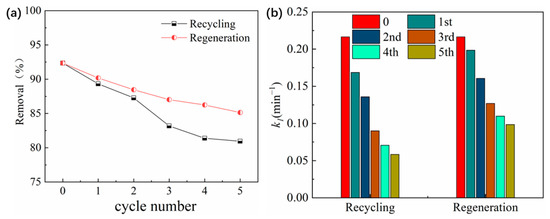
Figure 11.
Effect of cycling mode and number of cycles on degradation of SMZ (a) removal rate, (b) reaction constant.
2.4. Analysis of the Effect of β-CD in Improving Graphene Agglomeration
As shown in Figure 12a–f, compared with N-rGO, the dispersibility of β/N-rGO remained stable over time, with no signs of agglomeration or settling, indicating that β-CD modification significantly enhanced the dispersibility of graphene in water. Characterization analysis indicated that β-CD modified graphene oxide primarily through covalent or non-covalent linkages. On one hand, covalent bonding results in the formation of a β-CD–graphene oxide hybrid, enhancing its water solubility. On the other hand, non-covalent interactions, such as Van der Waals forces, π–π stacking, and hydrogen bonding, cause β-CD to adsorb onto the surface of N-rGO, increasing the repulsive forces between graphene sheets. When this repulsive force exceeds the intrinsic intermolecular forces of graphene, the β/N-rGO sheets separate, leading to the formation of large edge defects and exposing more functional groups [27,32]. Furthermore, the potential direct effect of β-CD on PMS activation was investigated. As shown in Figure 12g, the EPR spectra of the reaction between β-CD and PMS did not show characteristic peaks for free radicals, such as ·SO4−, ·OH, or singlet oxygen, suggesting that the primary catalytic effect in PMS activation by β/N-rGO arose from the active sites within the structure of nitrogen-doped graphene itself. β-CD itself did not activate PMS; its primary effect on catalytic performance was enhancing the dispersion of nitrogen-doped graphene, thereby exposing more catalytic active sites and improving overall catalytic performance.
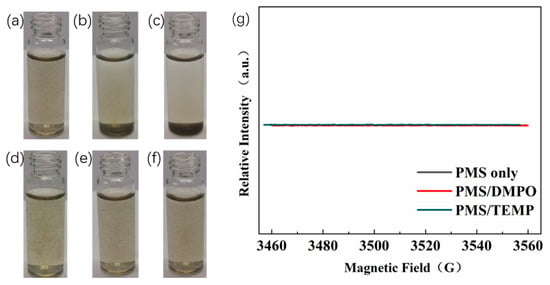
Figure 12.
Dispersion effects of N-rGO (a–c) and β/N-rGO (d–f) at 0, 5, and 10 min moments, (g) EPR spectra of the reaction of β-CD with PMS.
2.5. Quenching Experiments and EPR Spectra Analysis
As shown in Figure 13a, the addition of free radical scavengers, such as tert-butanol (TBA), methanol (MeOH), and p-benzoquinone (PBQ), had minimal impact on the degradation efficiency of SMZ, whereas β-carotene significantly reduced the degradation efficiency, highlighting the dominance of the non-radical oxidative pathway in the β/N-rGO + PMS system, where singlet oxygen plays a crucial role. Furthermore, the electron paramagnetic resonance (EPR) spectra in Figure 13b support the inference regarding the type of ROS activated by β/N-rGO in the PMS system. Triple peaks with greater intensity were observed in the presence of TEMP, a typical singlet oxygen signal, whereas the characteristic peaks captured by DMPO were weak, indicating that the concentrations of ·SO4− and ··OH in the system were minimal [61].
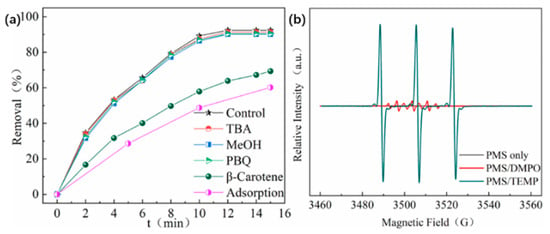
Figure 13.
(a) Quenching experiment (C0 = 10 μg/L, Cβ/N-rGO = 0.1 mg/L, CPMS = 1 mg/L, pH = 7), (b) EPR spectra.
3. Conclusions
In this study, β-CD was shown to functionalize graphene materials, effectively addressing the issue of agglomeration while enhancing their catalytic activity and application potential. Structural characterization confirmed that β-CD disperses effectively within the support structure of nitrogen-doped graphene, increasing the material’s specific surface area and enhancing its dispersibility. The “adsorption-catalytic oxidation” system consisting of β/N-rGO and PMS can degrade 92.35% of SMZ in 12 min, with the reaction time reduced by over 10% compared to the unmodified system. The degradation of various antibiotics, including sulfonamides, quinolones, macrolides, tetracyclines, β-lactams, and chloramphenicol, was observed to be effective across a pH range of 3 to 12, with a more pronounced improvement in degradation efficiency under acidic conditions when compared to the unmodified material. The system’s activation energy was calculated to be 4.5 kJ/mol, and common anions and humic acids in water did not impact the degradation of antibiotics by the β/N-rGO + PMS “adsorption-catalytic oxidation” system, which exhibited a long service life, with a removal rate of 85% after five regeneration cycles. Quenching experiments and EPR spectra confirmed that the primary reaction pathway for PMS activation by β/N-rGO is a non-radical pathway dominated by singlet oxygen. Therefore, β-CD functionalization is a key method for improving the agglomeration behavior of graphene-based materials, enhancing not only the dispersion of graphene but also the interfacial interactions, thereby promoting the advancement of material applications.
4. Experiments and Methods
4.1. Catalyst Preparation
Graphene oxide (GO) and nitrogen-doped reduced graphene oxide (N-rGO) were synthesized following the same procedure as described in the previous study [42]. After preparing a 0.5 g/L N-rGO and 4 g/L β-CD aqueous solution, 100 mL of this solution was transferred into a 250 mL conical flask. Then, 1.5 mL of ammonia (NH4·H2O) was added, and the mixture was thoroughly mixed. The solution was then sonicated for 5 min and placed in a 60 °C water bath for 3 h of reaction. After the reaction, the mixture was centrifuged, and the resulting graphene was dried at 60 °C for 12 h. Upon completion of the reaction, the powder was ground and passed through a 100-mesh sieve to obtain the β-CD-nitrogen-doped reduced graphene oxide powder, labeled β/N-rGO.
4.2. Experimental Methods
A total of 80 mL of 12.5 μg/L antibiotic solution and 10 mL of β/N-rGO dispersion (1 mg/L) were added to a 120 mL amber vial. Without allowing adsorption equilibrium to be reached, 10 mL of 10 mg/L PMS solution was immediately added, and the mixture was briefly shaken before initiating the catalytic reaction on a shaker. The pH range of the reaction was 3–12, with temperatures of 288.15, 298.15, and 308.15 K. The anion concentration was 100 mmol/L, and humic acid concentrations were 1, 5, and 10 mg/L. The catalysts were not regenerated during the cycling experiments. After each degradation process, the reactants were directly added for the next cycle, which was repeated five times. In the regeneration cycle experiment, 10 mL of a 100 µg/L antibiotic solution and 120 mg of potassium PMS were added as reactants. Eluents included 0.1 mol/L hydrochloric acid, 0.1 mol/L sodium hydroxide, and deionized water.
Tert-butanol (TBA), methanol (MeOH), p-benzoquinone (PBQ), and β-carotene were employed as blockers of reactive oxygen species (ROS) reactions, and overdosing was applied to evaluate whether the ROS reaction was inhibited. Then, 5,5-dimethyl-1-pyrroline-N-oxide (DMPO) was employed as a trapping agent for sulfate and hydroxyl radicals, while 2,2,6,6-tetramethylpiperidine (TEMP) was used to trap singlet oxygen. Electron paramagnetic resonance (EPR) was utilized to capture and characterize ROS.
4.3. Antibiotic Concentration Testing
The concentration of antibiotics was determined using the HPLC method with a C18 column, and the experimental conditions were as follows:
- (1)
- Sulfamethoxazole (SMZ): The mobile phase consisted of water, acetonitrile, and triethylamine in a volume ratio of 799:200:1. Sodium hydroxide or glacial acetic acid was used to adjust the pH to 5.9. The flow rate was 1 mL/min, and the wavelength was 240 nm.
- (2)
- Levofloxacin (LVX): The mobile phase consisted of 0.05 mol/L potassium dihydrogen phosphate (pH adjusted to 2.8 with phosphoric acid) and acetonitrile (v/v: 82:18). The flow rate was 1 mL/min, and the wavelength was 293 nm.
- (3)
- Clindamycin (CLI): The mobile phase consisted of 0.68 g/L potassium dihydrogen phosphate (pH adjusted to 7.5 with 250 g/L sodium hydroxide) and acetonitrile (v/v: 5:45). The flow rate was 1 mL/min, and the wavelength was 210 nm.
- (4)
- Tetracycline (TC): The mobile phase consisted of methanol and 0.02 mol/L potassium dihydrogen phosphate (pH 2.0 adjusted with nitric acid) in a volume ratio of 12:88. The flow rate was 1 mL/min, and the wavelength was 280 nm.
- (5)
- Penicillin G sodium (PEN): The mobile phase consisted of 0.1 mol/L potassium dihydrogen phosphate (pH 2.5 adjusted with phosphoric acid) and acetonitrile in a volume ratio of 70:30. The flow rate was 1 mL/min, and the wavelength was 225 nm.
- (6)
- Chloramphenicol (CHL): The mobile phase consisted of methanol and water in a volume ratio of 6:4. The flow rate was 0.5 mL/min, and the wavelength was 272 nm.
4.4. Characterization Methods
The material morphology was characterized using scanning electron microscopy (SEM) (ZEISS, Suzhou, China). Fourier-transform infrared (FTIR) (BRUKER, Ettlingen, Germany) spectroscopy was employed to analyze the distribution and changes in functional groups in graphene materials. X-ray photoelectron spectroscopy (XPS) (PANalytical, Almelo, Netherlands) was used to characterize the C-N bonding structure and the bonding characteristics of oxygen-containing functional groups. Raman spectroscopy (Renishaw, Gloucestershire, Britain) was employed to accurately distinguish defects in the graphene structure.
Author Contributions
Data curation, M.Y.; formal analysis, M.Y. and N.W.; writing—original draft, M.Y.; conceptualization, N.W.; resources, N.W.; writing—review and editing, N.W. All authors have read and agreed to the published version of the manuscript.
Funding
This research was funded by the Natural Science Foundation of Gansu Province (No. 24JRRA240), the Innovation Project of Gansu Province University Faculty Fund (No. 2024A-034), the Project Supported by the Young Scholars Science Foundation of Lanzhou Jiaotong University (2022045), and Tianyou Youth Talent Lift Program of Lanzhou Jiaotong University.
Data Availability Statement
Data will be made available on request.
Conflicts of Interest
The authors declare no conflicts of interest.
References
- Guo, M.; Yuan, H.; Ni, K.; Ye, C.; Pan, F.; Xiong, J.; Zhu, Y. Structural repair of reduced graphene oxide promoted by single-layer graphene. Adv. Sci. 2025, 12, 2410088. [Google Scholar] [CrossRef] [PubMed]
- Zhang, Y.; Zhang, H.; Wang, X.; Shi, X.; Zhao, Z.; Wang, Y.; Liu, J.; Tang, C.; Wang, G.; Li, L. Graphene nanoribbons enhancing the electronic conductivity and ionic diffusion of graphene electrodes for high-performance microsupercapacitors. Energy Environ. Mater. 2024, 7, e12681. [Google Scholar] [CrossRef]
- Fan, X.; He, C.; Ding, J.; Gao, Q.; Ma, H.; Lemme, M.C.; Zhang, W. Graphene MEMS and NEMS. Microsyst. Nanoeng. 2024, 10, 154. [Google Scholar] [CrossRef] [PubMed]
- Gronkiewicz, K.; Richter, L.; Knechtel, F.; Pyrcz, P.; Leidinger, P.; Günther, S.; Ploetz, E.; Tinnefeld, P.; Kamińska, I. Expanding the range of graphene energy transfer with multilayer graphene. Nanoscale 2024, 16, 13464–13470. [Google Scholar] [CrossRef]
- Gu, W.; Yang, M.; Chen, Z.; Cao, T.; Zhang, Y.; Li, Y.; Zhang, R. New insights into enhanced electrochemical advanced oxidation mechanism of B-doped graphene aerogel: Experiments, molecular dynamics simulations and DFT. J. Hazard. Mater. 2023, 443, 130331. [Google Scholar] [CrossRef]
- Zhang, Y.; Zhang, Z. A sustainable and metal-free advanced oxidation process for efficient water purification by electrified reduced graphene oxide membrane. Chem. Catal. 2024, 4, 101056. [Google Scholar] [CrossRef]
- Wang, H.; Xu, Z.; Yang, X. Probing the formation mechanisms of reactive oxygen species in graphene oxide-catalyzed ozone advanced oxidation processes. Carbon 2025, 233, 119831. [Google Scholar] [CrossRef]
- Su, P.; Zhou, M.; Lu, X.; Yang, W.; Ren, G.; Cai, J. Electrochemical catalytic mechanism of N-doped graphene for enhanced H2O2 yield and in-situ degradation of organic pollutant. Appl. Catal. B Environ. 2019, 245, 583–595. [Google Scholar] [CrossRef]
- Long, Y.; Dai, J.; Zhao, S.; Su, Y.; Wang, Z.; Zhang, Z. Atomically dispersed cobalt sites on graphene as efficient periodate activators for selective organic pollutant degradation. Environ. Sci. Technol. 2021, 55, 5357–5370. [Google Scholar] [CrossRef]
- Li, X.; Chen, X.; Yan, Y.; Wang, F.; Feng, L.; Chen, Y. Nitrogen-doped graphene for tetracycline removal via enhancing adsorption and non-radical persulfate activation. Environ. Res. 2023, 235, 116642. [Google Scholar] [CrossRef]
- Liu, X.; Zhang, Y. Nitrogen-doped reduced graphene oxide (N-rGO) three-dimensional electrode electrochemically activates persulfate for the degradation of tetracycline. Carbon Lett. 2024, 34, 865–34879. [Google Scholar] [CrossRef]
- Hirani, R.A.K.; Asif, A.H.; Rafique, N.; Shi, L.; Zhang, S.; Saunders, M.; Tian, W.; Wang, S.; Sun, H. Heterogeneous activation of persulfate by macroscopic nitrogen-doped graphene oxide cubes for the degradation of antibiotic contaminants in water. Sep. Purif. Technol. 2023, 319, 124110. [Google Scholar] [CrossRef]
- Jiang, X.; Wang, R.; Yang, Q.; Guo, W.; Ren, X. Surface-regulated FexOy/NG catalysts enhancing persulfate activation to remove tetracycline via a singlet oxygen-dominated pathway. Sep. Purif. Technol. 2025, 361, 131570. [Google Scholar] [CrossRef]
- Luo, J.; Yang, L.; Sun, D.; Gao, Z.; Jiao, K.; Zhang, J. Graphene oxide “surfactant”-directed tunable concentration of graphene dispersion. Small 2020, 16, 2003426. [Google Scholar] [CrossRef]
- Sonin, A.S.; Churochkina, N.A.; Kaznacheev, A.V.; Golovanov, A.V. Mesomorphism of graphene oxide dispersions. Colloid J. 2021, 83, 161–182. [Google Scholar] [CrossRef]
- Zhang, N.; Ma, P.; Yang, Z.; Fang, Y.; Zhang, Z. Physical dispersion method and mechanism of graphene. J. Superhard Mater. 2023, 45, 186–191. [Google Scholar] [CrossRef]
- Li, L.; Zhou, M.; Jin, L.; Mo, Y.; Xu, E.; Chen, H.; Liu, L.; Wang, M.; Chen, X.; Zhu, H. Green preparation of aqueous graphene dispersion and study on its dispersion stability. Materials 2020, 13, 4069. [Google Scholar] [CrossRef]
- Wang, Q.; Zhan, D.; Qi, G.; Wang, Y.; Zheng, H. Impact of the microstructure of polycarboxylate superplasticizers on the dispersion of graphene. New Carbon Mater. 2020, 35, 547–558. [Google Scholar] [CrossRef]
- Qamar, S.; Ramzan, N.; Aleem, W. Graphene dispersion, functionalization techniques and applications: A review. Synth. Met. 2024, 307, 117697. [Google Scholar] [CrossRef]
- Feng, B.; Wang, Z.; Suo, W.; Wang, Y.; Wen, J.; Li, Y.; Suo, H.; Liu, M.; Ma, L. Performance of graphene dispersion by using mixed surfactants. Mater. Res. Express 2020, 7, 095009. [Google Scholar] [CrossRef]
- Wilczewski, S.; Skórczewska, K.; Tomaszewska, J.; Lewandowski, K.; Szulc, J.; Runka, T. Manufacturing homogenous PVC/graphene nanocomposites using a novel dispersion agent. Polym. Test. 2020, 91, 106868. [Google Scholar] [CrossRef]
- Zhao, W.; Sugunan, A.; Gillgren, T.; Larsson, J.A.; Zhang, Z.; Zhang, S.; Nordgren, N.; Sommertune, J.; Ahniyaz, A. Surfactant-free stabilization of aqueous graphene dispersions using starch as a dispersing agent. ACS Omega 2021, 6, 12050–12062. [Google Scholar] [CrossRef]
- Sun, L.; Xu, G.; Tu, Y.; Zhang, W.; Hu, X.; Yang, P.; Wu, D.; Liang, Y.; Wei, D.; Li, A.; et al. Multifunctional porous β-cyclodextrin polymer for water purification. Water Res. 2022, 222, 118917. [Google Scholar] [CrossRef]
- Bie, W.; Zhang, S.; Zhang, L.; Li, H.; Sun, X.; Cai, T.; Wang, Z.; Kong, F.; Wang, W. Thioether-functionalized porous β-cyclodextrin polymer for efficient removal of heavy metal ions and organic micropollutants from water. Carbohydr. Polym. 2024, 324, 121509. [Google Scholar] [CrossRef]
- Zhang, W.; Sun, P.; Liu, D.; Zhao, Q.; Zou, B.; Zhou, L.; Ye, Z. Method to fabricate porous multifunction β-cyclodextrin modified resin for ultrafast and efficient removal of Cu(II) and bisphenol A. J. Taiwan Inst. Chem. E 2021, 119, 286–297. [Google Scholar] [CrossRef]
- Xiong, T.; Zou, C.; Lin, S. β-Cyclodextrin magnetic graphene oxide (β-CD@MGO) for efficient removal of Ni(II) and phenol: Adsorption performance, reusability and adsorption mechanism studies. Diam. Relat. Mater. 2023, 139, 110269. [Google Scholar] [CrossRef]
- Verma, M.; Hong, Y.; Kumar, V.; Bisht, B.M.; Vlaskin, S.; Chae, S.; Shah, K.J.; Kim, H. Enhanced removal and stepwise recovery of inorganic and organic micropollutants from water using novel graphene oxide doped multifunctional β−cyclodextrin chitosan polymer. J. Phys. Chem. Solids 2023, 182, 111615. [Google Scholar] [CrossRef]
- Almajidi, Y.Q.; Majeed, A.A.; Ali, E.; Abdullaev, S.; Koka, N.A.; Bisht, Y.S.; Fenjan, M.N.; Alawadi, A.; Alsalamy, A.; Saleh, L.H. A versatile magnetic nanocomposite based on cellulose-cyclodextrin hydrogel embedded with graphene oxide and Cu2O nanoparticles for catalytic application. Int. J. Biol. Macromol. 2024, 260, 129367. [Google Scholar] [CrossRef] [PubMed]
- Zhu, M.; Liang, H.; Gong, X. A novel magnetic β-cyclodextrin-modified graphene oxide and chitosan composite as an adsorbent for trace extraction of four bisphenol pollutants from environmental water samples and food samples. Environ. Res. 2024, 29, 867. [Google Scholar] [CrossRef]
- Ouyang, J.; Gao, J.; Shen, J.; Wei, Y.; Wang, C. Preparation of magnetic graphene/β-cyclodextrin polymer composites and their application for removal of organic pollutants from wastewater. J. Environ. Chem. Eng. 2023, 11, 110944. [Google Scholar] [CrossRef]
- Wang, X.; Chen, J.; Zhou, J.; Bao, L.; Zhang, L.; Yang, L.; Wu, J.; Hao, C. Novel carboxymethyl cellulose-based hydrogel embedded with metal organic framework for efficient cationic dye removal from water. Int. J. Biol. Macromol. 2024, 282, 137387. [Google Scholar] [CrossRef] [PubMed]
- Nie, Z.; Guo, Q.; Xia, H.; Song, M.; Qiu, Z.; Fan, S.; Chen, Z.; Zhang, S.; Zhang, S.; Li, B. Cyclodextrin self-assembled graphene oxide aerogel microspheres as broad-spectrum adsorbent for removing dyes and organic micropollutants from water. J. Environ. Chem. Eng. 2021, 9, 104749. [Google Scholar] [CrossRef]
- Zang, X.; Liang, L.; Wang, X.; Li, C.; Li, P.; Shao, Q.; Cao, N. β-Cyclodextrin anchor NiCo2S4 on graphene to enhance electrochemical performance of supercapacitor. Energy Technol. 2022, 10, 2200490. [Google Scholar] [CrossRef]
- Qu, Y.; Li, H.; Yakub, I.; He, W.; Dong, W.; Barawi, M.H.; Wang, S.; Ma, H.; Zhu, Z. Synthesis and characterization of efficient adsorbents for methylene blue based on graphene oxide/β-cyclodextrin composites. Water Air Soil Pollut. 2025, 56, 236. [Google Scholar] [CrossRef]
- Yang, X.; Wu, Y.; Qi, Y.; Zheng, M.; Xie, F.; Wang, Q.; Xiao, X.; Xiao, D. Multifunctional bionanohybrids of graphene oxide/β-cyclodextrin for applications in methylene blue adsorption, solvent response, and smart light-driven. J. Mol. Liq. 2024, 404, 124977. [Google Scholar] [CrossRef]
- Wang, J.; Sha, X.; Chen, X.; Zhuo, H.; Xie, W.; Zhou, Z.; He, X.; Wu, L.; Li, B. Removal and distribution of antibiotics and resistance genes in conventional and advanced drinking water treatment processes. J. Water Process Eng. 2022, 50, 103217. [Google Scholar] [CrossRef]
- Zhang, G.; Zhang, C.; Liu, J.; Zhang, Y.; Fu, W. Occurrence, fate, and risk assessment of antibiotics in conventional and advanced drinking water treatment systems: From source to tap. J. Environ. Manag. 2024, 358, 120746. [Google Scholar] [CrossRef]
- Ashish, K.; Rajinder, K.; Shashikala, V.; Samer, S. Antimicrobials and antibiotic resistance genes in water bodies: Pollution, risk, and control. Front. Environ. Sci. 2022, 10, 830861. [Google Scholar] [CrossRef]
- Jerry, O.; Timothy, A.; Damian, C. Mineralization of antibiotics in wastewater via photocatalysis. Water Air Soil Pollut. 2021, 232, 219. [Google Scholar] [CrossRef]
- Xie, J.; Li, X.; Ma, W.; Wang, L.; Lu, Y.; Li, S.; Li, J.; Guo, X.; Li, Z.; Ding, C. Fate of dissolved organic matter and antibiotics in conventional treatment system and constructed wetlands system applied to source water pretreatment: Removal efficiency and risk assessment. Water Air Soil Pollut. 2024, 235, 24. [Google Scholar] [CrossRef]
- Wu, N.; Zhang, X.; Zhang, X.; Yang, K.; Li, Y. Simultaneous degradation of trace antibiotics in water by adsorption and catalytic oxidation induced by N-doped reduced graphene oxide (N-rGO): Synergistic mechanism. Mater. Res. Express 2022, 9, 065601. [Google Scholar] [CrossRef]
- Zhang, X.; Zhao, B.; Wu, N. Active sites and structure regulation of non-radical pathways in N-doped graphene-activated persulfate. Catal. Commun. 2024, 187, 106910. [Google Scholar] [CrossRef]
- Li, J.; Zhao, L.; Feng, M.; Huang, C.; Sun, P. Abiotic transformation and ecotoxicity change of sulfonamide antibiotics in environmental and water treatment processes: A critical review. Water Res. 2021, 202, 117463. [Google Scholar] [CrossRef]
- Guo, Y.; Guo, S.; Ren, J.; Zhai, Y.; Dong, S.; Wang, E. Cyclodextrin functionalized graphene nanosheets with high supramolecular recognition capability: Synthesis and host−Guest inclusion for enhanced electrochemical performance. ACS Nano 2010, 4, 4001–4010. [Google Scholar] [CrossRef]
- Zhao, F.; Repo, E.; Yin, D.; Meng, Y.; Jafari, S.; Sillanpää, M. EDTA-cross-linked β-cyclodextrin: An environmentally friendly bifunctional adsorbent for simultaneous adsorption of metals and cationic dyes. Environ. Sci. Technol. 2015, 49, 10570–10580. [Google Scholar] [CrossRef]
- Wang, J.; Chen, Z.; Chen, B. Adsorption of polycyclic aromatic hydrocarbons by graphene and graphene oxide nanosheets. Environ. Sci. Technol. 2014, 48, 4817–4825. [Google Scholar] [CrossRef] [PubMed]
- Chen, Z.; Liu, Z.; Zhang, L.; Cai, Q.; Hu, J.; Wang, W.; Ju, X.; Xie, R.; Chu, L. Functional graphene oxide nanosheets modified with cyclodextrins for removal of Bisphenol A from water. Chin. J. Chem. Eng. 2021, 39, 79–87. [Google Scholar] [CrossRef]
- Zhao, Z.; Long, X.; Millan, M.; Yuan, G.; Cui, Z.; Dong, Z.; Cong, Y.; Zhang, J.; Li, X. The influence of carbon supports and their surface modification on aqueous phase highly selective hydrogenation of phenol to cyclohexanol over different Ni/carbon catalysts. Carbon 2023, 213, 118227. [Google Scholar] [CrossRef]
- Tan, Y.; Zhao, N.; Song, Q.; Ling, H. Alkali synergistic sulfide-modified nZVI activation of persulfate for phenanthrene removal. Chem. Eng. J. 2023, 11, 109923. [Google Scholar] [CrossRef]
- Cheng, N.; Deng, F.; Wang, J.; Hu, L.; Yang, J.; Jiang, S.; Wang, H.; Ma, X.; Zhao, L.; Li, G.; et al. Simultaneous alkali recovery, coagulant recycling and organics removal from textile wastewater via membrane electrochemical system. Sep. Purif. Technol. 2025, 354, 129448. [Google Scholar] [CrossRef]
- Wang, C.; Kang, J.; Sun, H.; Ang, H.M.; Tadé, M.O.; Wang, S. One-pot synthesis of N-doped graphene for metal-free advanced oxidation processes. Carbon 2016, 102, 279–287. [Google Scholar] [CrossRef]
- Zhao, W.; Ye, C.; Li, J.; Yu, X. Increased risk of antibiotic resistance in surface water due to global warming. Environ. Res. 2024, 263, 120149. [Google Scholar] [CrossRef] [PubMed]
- Zhang, X.; Wu, N. Adsorption characteristics of N-rGO for multiple representative trace antibiotics in water. J. Environ. Qual. 2022, 51, 1298–1309. [Google Scholar] [CrossRef]
- Li, T.; Zhu, P.; Wang, D.; Zhang, Z.; Zhou, L. Efficient utilization of the electron energy of antibiotics to accelerate Fe(III)/Fe(II) cycle in heterogeneous Fenton reaction induced by bamboo biochar/schwertmannite. Environ. Res. 2022, 209, 112830. [Google Scholar] [CrossRef]
- Luo, Y.; Su, R. Cobalt-based MOF material activates persulfate to degrade residual ciprofloxacin. Water 2024, 16, 2299. [Google Scholar] [CrossRef]
- Carmen, S.; Luis, M. p-Nitrophenol degradation by activated persulfate. Environ. Technol. Innov. 2021, 21, 101265. [Google Scholar] [CrossRef]
- Tan, C.; Gao, N.; Deng, Y.; Zhang, Y.; Sui, M.; Deng, J.; Zhou, S. Degradation of antipyrine by UV, UV/H2O2 and UV/PS. J. Hazard. Mater. 2013, 260, 1008–1016. [Google Scholar] [CrossRef]
- Lou, X.; Wu, L.; Guo, Y.; Chen, C.; Wang, Z.; Xiao, D.; Fang, C.; Liu, J.; Zhao, J.; Lu, S. Peroxymonosulfate activation by phosphate anion for organics degradation in water. Chemosphere 2014, 117, 582–585. [Google Scholar] [CrossRef] [PubMed]
- Gu, D.; Guo, C.; Hou, S.; Lv, J.; Zhang, Y.; Feng, Q.; Zhang, Y.; Xu, J. Kinetic and mechanistic investigation on the decomposition of ketamine by UV-254 nm activated persulfate. Chem. Eng. J. 2019, 370, 19–26. [Google Scholar] [CrossRef]
- Dan, J.; Wang, Q.; Mu, K.; Rao, P.; Dong, L.; Zhang, X.; He, Z.; Gaod, N.; Wang, J. Degradation of sulfachloropyridazine by UV-C/persulfate: Kinetics, key factors, degradation pathway. Environ. Sci. Water Res. 2020, 6, 2510–2520. [Google Scholar] [CrossRef]
- Fan, Z.; Feng, T.; Wu, S.; Wang, S.; Tan, Y.; Yu, Q.; Huang, R.; Zhang, X. Chitin-derived biochar with nitrogen doping to activate persulfate for phenol degradation: Application potential and electron transfer pathway in system. Chemosphere 2023, 330, 138641. [Google Scholar] [CrossRef] [PubMed]
Disclaimer/Publisher’s Note: The statements, opinions and data contained in all publications are solely those of the individual author(s) and contributor(s) and not of MDPI and/or the editor(s). MDPI and/or the editor(s) disclaim responsibility for any injury to people or property resulting from any ideas, methods, instructions or products referred to in the content. |
© 2025 by the authors. Licensee MDPI, Basel, Switzerland. This article is an open access article distributed under the terms and conditions of the Creative Commons Attribution (CC BY) license (https://creativecommons.org/licenses/by/4.0/).